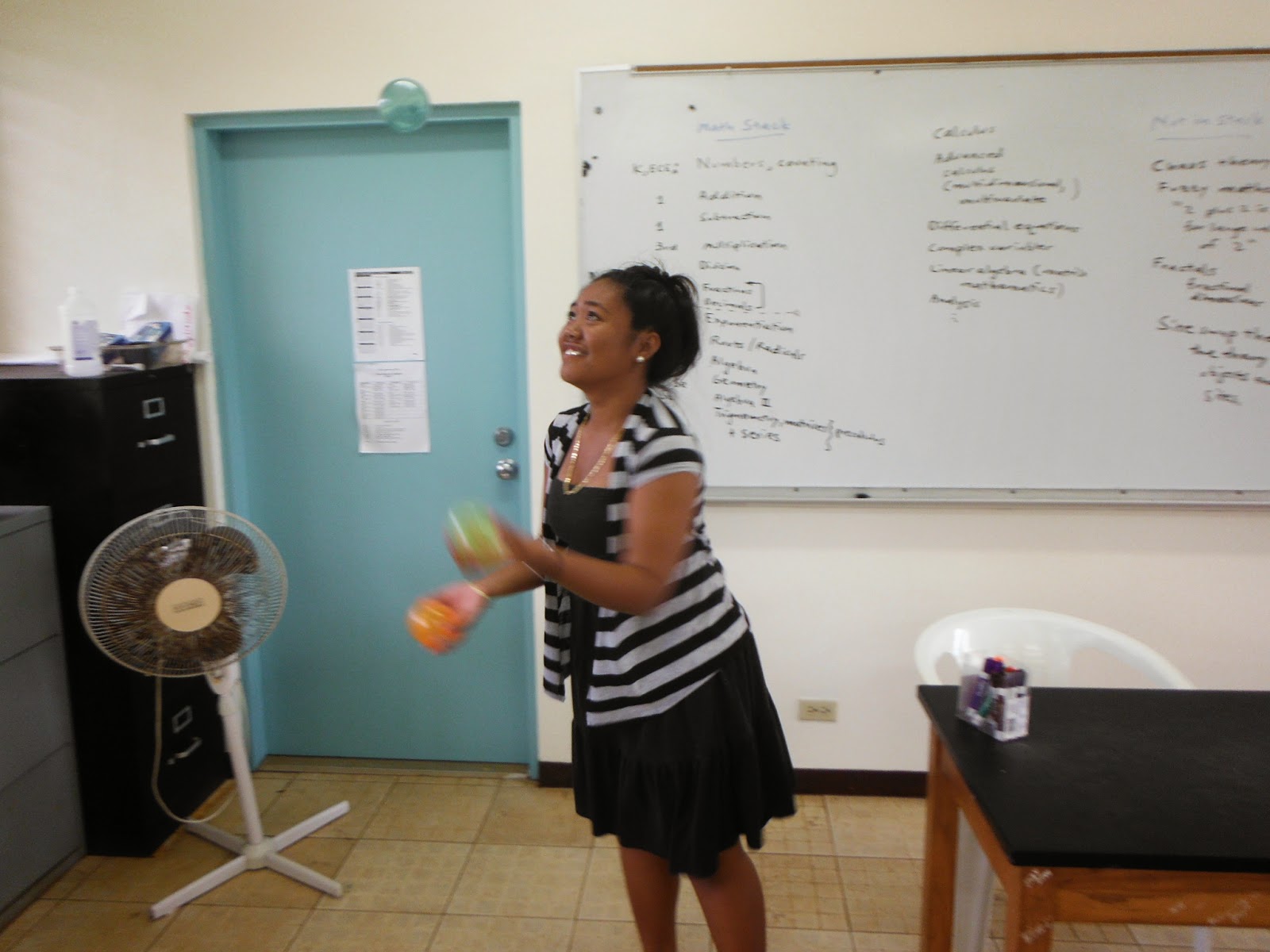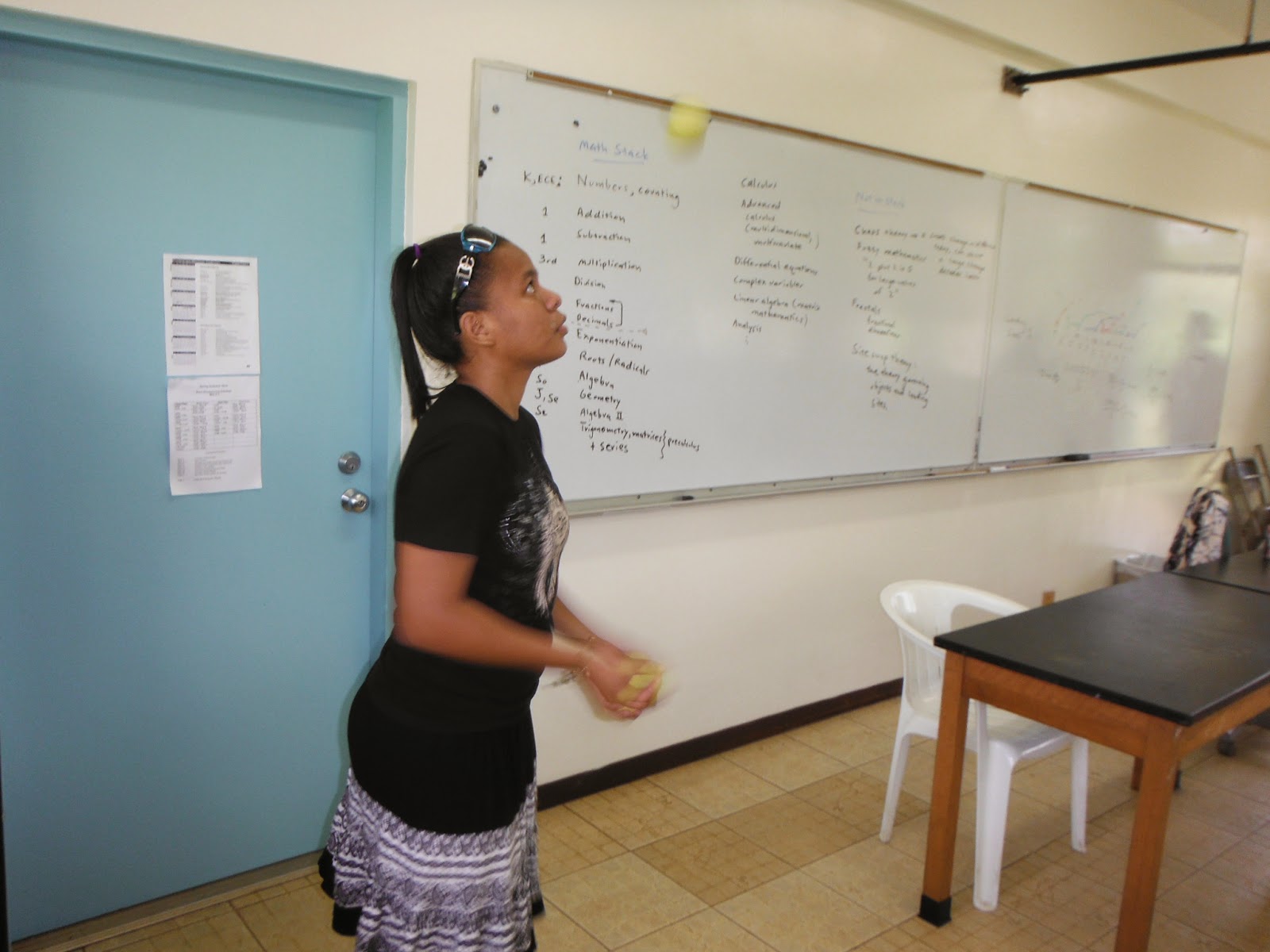Site swap notation
Laboratory fifteen in physical science seeks to expand the students thinking about mathematical models beyond algebraic models.
I open the class with a question and answer on what mathematics is introduced in schools and when. I start from counting in kindergarten and ask the class to tell me when addition, subtraction, multiplication, division, fractions, decimals, variables, and so forth are introduced.
I asked the class, "As some point did you ever wonder, ever ask, what was usefulness of the mathematics? Did a teacher ever tell you, 'You need to learn this so you can do algebra?' Or whatever the next topic in the math stack might be?"
I then share the worst kept secret in mathematics education. The secret that one never has to solve a quadratic equation in life, with the exceptions of some engineers and scientists. The average human life on the planet never has to solve a quadratic equation. At least not until your child comes home with algebra homework and says, "Dad, how do I solve this?"
One of the core themes in the course is that mathematics underlies all physical systems. Linear relationships, quadratic, even rational functions. Students obtain these relationships from data gathered in the laboratory. The relationships are based in concretely observed and measured phenomena.
Not only does the data generate a model, but the model predicts what the system will do. Mathematics as a source of ideas, as per a quote from Freeman Dyson, "For a physicist mathematics is not just a tool by means of which phenomena can be calculated, it is the main source of concepts and principles by means of which new theories can be created... ...equations are quite miraculous in a certain way. I mean, the fact that nature talks mathematics, I find it miraculous. I mean, I spent my early days calculating very, very precisely how electrons ought to behave. Well, then somebody went into the laboratory and the electron knew the answer. The electron somehow knew it had to resonate at that frequency which I calculated. So that, to me, is something at the basic level we don't understand. Why is nature mathematical? But there's no doubt it's true. And, of course, that was the basis of Einstein's faith. I mean, Einstein talked that mathematical language and found out that nature obeyed his equations, too. "
Even though the vast majority my students are not going on to become scientists, they can at least gain a glimpse of mathematics in use, the mathematical philosophical underpinnings of science.
In this final laboratory I introduce a form of mathematical notation that is very different from anything the students have encountered before. Site swap notation. And I use the site swap from a 333 to a 342 to show that the mathematical model can make a prediction. Juggling a 33342333 sequences is the experimental proof that the mathematical prediction is valid.
This leads naturally to another theme in the course, the nature of proof in science. Science is a field of inquiry which produces testable predictions. Of course this is an issue with string theory at present - there do not seem to be obviously testable predictions thus far.
I wrap up the site swap laboratory by giving the students the opportunity to juggle, or to learn to juggle. This ends the class on a positive note. Daniel Kahneman in Thinking, Fast and Slow noted that the remembering mind rates experiences using a peak-end rule. This laboratory provides a positive experience to cap off the term, an end memory of having had fun in the class.
Marlynn Fredrick already knew how to juggle as the sequence of photos demonstrates
I open the class with a question and answer on what mathematics is introduced in schools and when. I start from counting in kindergarten and ask the class to tell me when addition, subtraction, multiplication, division, fractions, decimals, variables, and so forth are introduced.
I asked the class, "As some point did you ever wonder, ever ask, what was usefulness of the mathematics? Did a teacher ever tell you, 'You need to learn this so you can do algebra?' Or whatever the next topic in the math stack might be?"
I then share the worst kept secret in mathematics education. The secret that one never has to solve a quadratic equation in life, with the exceptions of some engineers and scientists. The average human life on the planet never has to solve a quadratic equation. At least not until your child comes home with algebra homework and says, "Dad, how do I solve this?"
One of the core themes in the course is that mathematics underlies all physical systems. Linear relationships, quadratic, even rational functions. Students obtain these relationships from data gathered in the laboratory. The relationships are based in concretely observed and measured phenomena.
Natasha Edwin getting site swap 3 started
Not only does the data generate a model, but the model predicts what the system will do. Mathematics as a source of ideas, as per a quote from Freeman Dyson, "For a physicist mathematics is not just a tool by means of which phenomena can be calculated, it is the main source of concepts and principles by means of which new theories can be created... ...equations are quite miraculous in a certain way. I mean, the fact that nature talks mathematics, I find it miraculous. I mean, I spent my early days calculating very, very precisely how electrons ought to behave. Well, then somebody went into the laboratory and the electron knew the answer. The electron somehow knew it had to resonate at that frequency which I calculated. So that, to me, is something at the basic level we don't understand. Why is nature mathematical? But there's no doubt it's true. And, of course, that was the basis of Einstein's faith. I mean, Einstein talked that mathematical language and found out that nature obeyed his equations, too. "
Natasha, ball one headed left
Even though the vast majority my students are not going on to become scientists, they can at least gain a glimpse of mathematics in use, the mathematical philosophical underpinnings of science.
Jerissa Salvador, first toss high
In this final laboratory I introduce a form of mathematical notation that is very different from anything the students have encountered before. Site swap notation. And I use the site swap from a 333 to a 342 to show that the mathematical model can make a prediction. Juggling a 33342333 sequences is the experimental proof that the mathematical prediction is valid.
Jerisse
This leads naturally to another theme in the course, the nature of proof in science. Science is a field of inquiry which produces testable predictions. Of course this is an issue with string theory at present - there do not seem to be obviously testable predictions thus far.
Isako Sohar demonstrates juggling while sitting
I wrap up the site swap laboratory by giving the students the opportunity to juggle, or to learn to juggle. This ends the class on a positive note. Daniel Kahneman in Thinking, Fast and Slow noted that the remembering mind rates experiences using a peak-end rule. This laboratory provides a positive experience to cap off the term, an end memory of having had fun in the class.
Isako
Viola John
Beverly Billy, J-Dina Dinney
Viola John, well controlled cascade
J-Dina
Gisele Roland
Midson Tom
Gisele
Lesleena Iriarte
Viola, three ball cascade outside
Viola had a very controlled three ball cascade. She was asked to pose for these with the campus as a backdrop.
Viola
J-Dina, high throws leading to having to chase down the inbound ball
J-Dina
Nena Nena
Lynnsey Sigrah




























Comments
Post a Comment